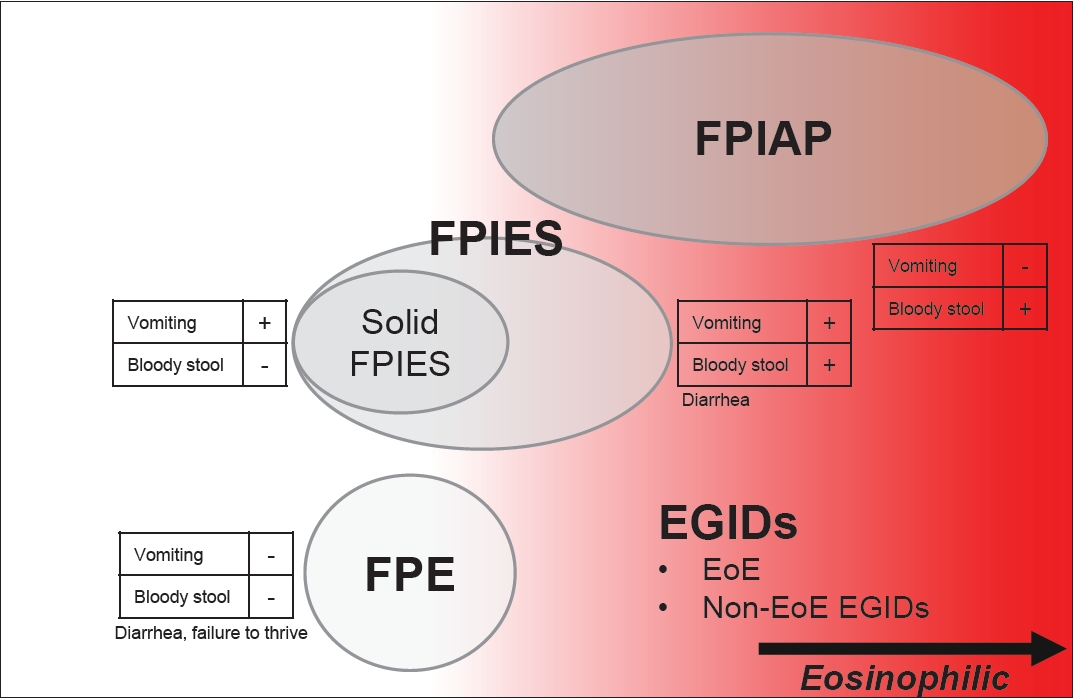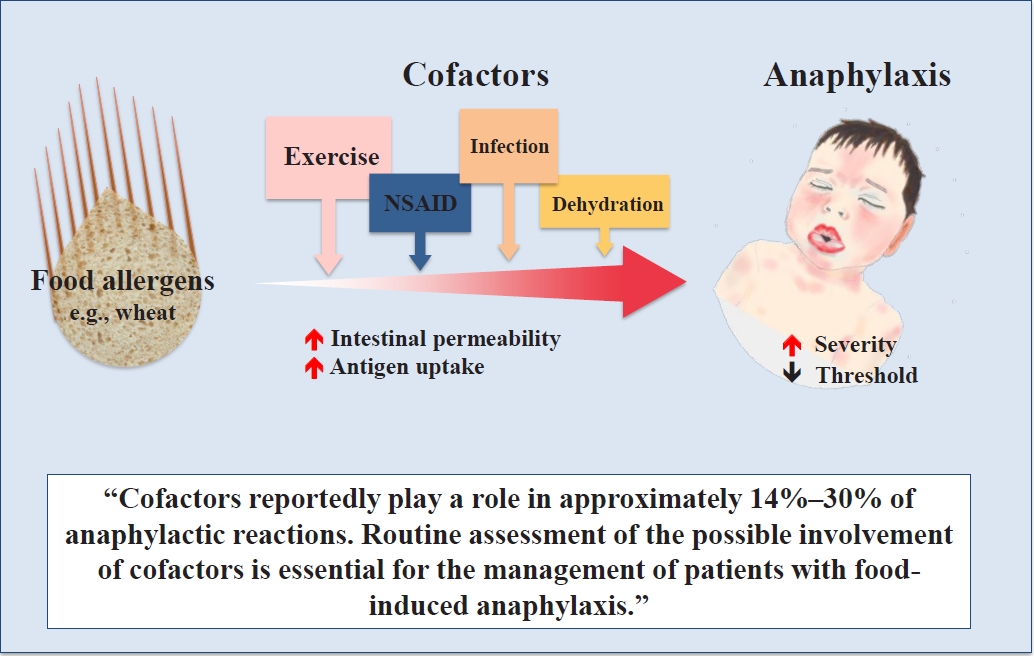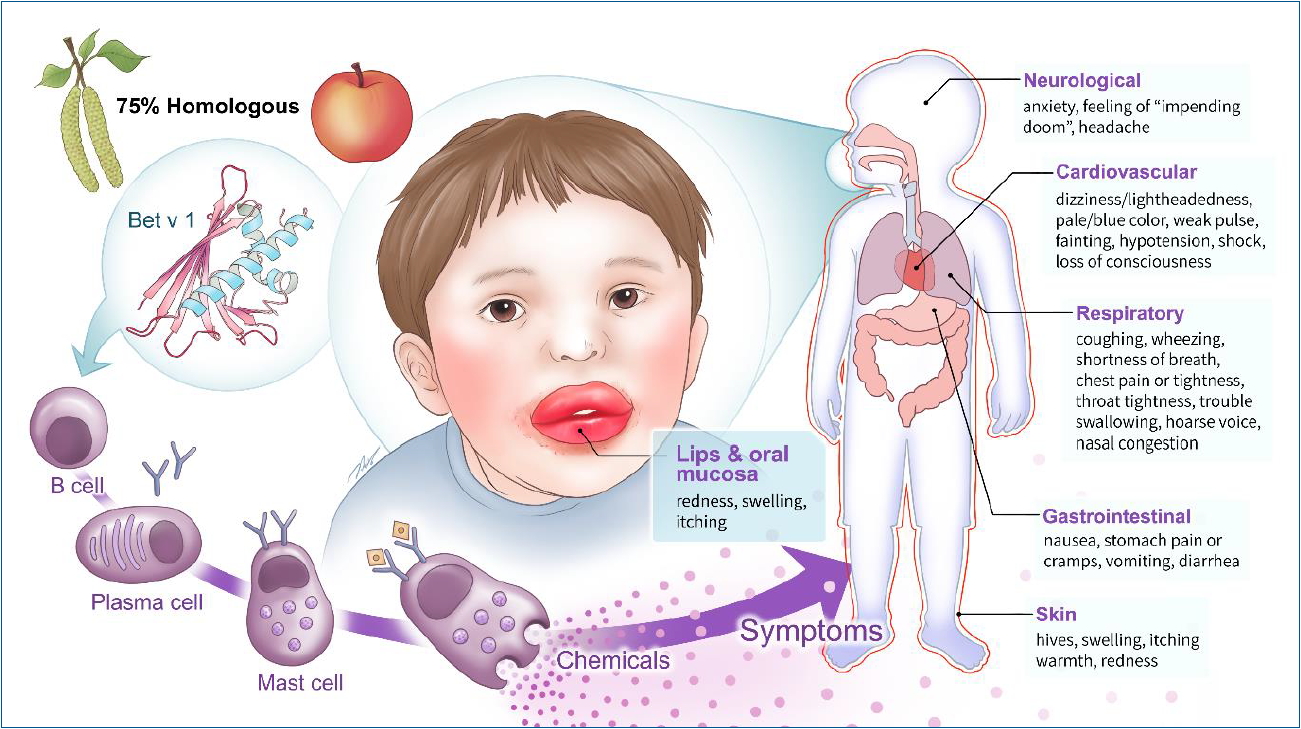Search
- Page Path
-
- HOME
- Search
- Review Article
- Allergy
- Natural course of IgE-mediated food allergy in children
- Kyunguk Jeong, Sooyoung Lee
- Clin Exp Pediatr. 2023;66(12):504-511. Published online June 14, 2023
-

· Dendritic, regulatory T, and regulatory B cells significantly contribute to the natural course of food allergy.
· Cow’s milk and hen’s egg allergies tend to resolve in earlier childhood but recent studies show that 50% of patients still persist into school age.
· The potential factors affecting the natural course of food allergy are age at diagnosis, symptom severity, sensitization status and its change rate, and external factors such as diet and interventions.
· There is a considerable possibility of food allergy outgrow if specific IgE levels are 2–5 kUA/L or less, but other factors such as age and recent symptoms should be considered together.
· With a clear understanding of the natural course of food allergy, pediatricians can provide appropriate assessment and interventions to our patients, and consequently can help patients overcome their food allergy and improve the social safety net.
- Recent topics on gastrointestinal allergic disorders
- Yoshiyuki Yamada
- Clin Exp Pediatr. 2023;66(6):240-249. Published online January 9, 2023
-

Gastrointestinal (GI) allergies are divided into immunoglobulin E (IgE)-mediated, non-IgE-mediated, and mixed types. In addition to non-IgE-mediated, overlapping eosinophilic GI disorders (EGIDs) have increased in Japan. EGIDs, a mixed-type allergy category, include eosinophilic esophagitis (EoE) and non-EoE EGIDs. The number of EoE cases has increased in Western countries, followed by Asian countries. Recent GI allergies may also be associated with type 2 inflammation.
- Food allergies and food-induced anaphylaxis: role of cofactors
- Meeyong shin
- Clin Exp Pediatr. 2021;64(8):393-399. Published online November 12, 2020
-

Question: What are the roles of cofactors in food allergies and food-induced anaphylaxis?
Finding: Cofactors reportedly play a role in approximately 14%–30% of anaphylactic reactions. Cofactors such as exercise, infection, nonsteroidal anti-inflammatory drugs, dehydration, and alcohol can increase intestinal permeability and antigen uptake, thereby causing allergic symptoms.
Meaning: Routine assessment of the possible involvement of cofactors is essential for the management of patients with food-induced anaphylaxis.
- Pollen-food allergy syndrome in children
- You Hoon Jeon
- Clin Exp Pediatr. 2020;63(12):463-468. Published online May 14, 2020
-

The prevalence of pollen-food allergy syndrome (PFAS) in Korean children with pollen allergy was recently reported to be 42.7%. PFAS can cause a wide range of symptoms from mild allergy to severe anaphylaxis depending on the nature of food allergens that share the epitopes with pollen. Cases of anaphylaxis caused by PFAS have recently increased. Treatments for PFAS should be individualized for patients according to the severity of symptoms.
- Drug Allergy in Children: What Should We Know?
- Ji Soo Park, Dong In Suh
- Clin Exp Pediatr. 2020;63(6):203-210. Published online November 12, 2019
-

The drug allergy “label” may have a lifetime of consequences for a child. Many children with alleged drug allergies are proven to be tolerant to the culprit medication when challenged. The field of drug hypersensitivity is a recently evolving field of research, but studies on its epidemiology and diagnostic tools are lacking in children. Clinical history is significant in the...
- Original Article
- Allergy
- Clinical and laboratory findings of childhood buckwheat allergy in a single tertiary hospital
- Kyujung Park, Kyunguk Jeong, Sooyoung Lee
- Clin Exp Pediatr. 2016;59(10):402-407. Published online October 17, 2016
-
Purpose Buckwheat allergy is one of the most severe types of food allergy in some countries, especially among children. However, few studies have investigated this condition. The aim of this study was to report the clinical and laboratory findings in Korean children with buckwheat allergy.
Methods Thirty-seven subjects, aged 1 to 14 years, were enrolled by retrospective medical record review from January 2000...
- The relationships among birth season, sunlight exposure during infancy, and allergic disease
- Jung Min Hwang, Se Hyun Oh, Mee Yong Shin
- Clin Exp Pediatr. 2016;59(5):218-225. Published online May 31, 2016
-
Purpose The recent increase in the prevalence of allergic diseases is hypothetically attributed to immune dysregulation in turn caused by a reduction in exposure to sunlight. We explored relationships between birth season, sunlight exposure, exercise duration, and an allergic disease.
Methods We performed a questionnaire-based survey on allergic diseases among elementary school students. Birth time was categorized according to the season (summer and...
- Food allergen sensitization in young children with typical signs and symptoms of immediate-type food allergies: a comparison between monosensitized and polysensitized children
- Na Yeon Kim, Ga Ram Kim, Joon Hwan Kim, Ji Hyeon Baek, Jung Won Yoon, Hye Mi Jee, Hye Sung Baek, Yong Ho Jung, Sun Hee Choi, Ki Eun Kim, Youn Ho Shin, Hye Yung Yum, Man Yong Han, Kyu-Earn Kim
- Clin Exp Pediatr. 2015;58(9):330-335. Published online September 21, 2015
-
Purpose The clinical interpretation of children sensitized to allergens is challenging, particularly in children with food allergies. We aimed to examine clinical differences between children with monosensitization and those with polysensitization to common food allergens and to determine risk factors for polysensitization in young children <10 years of age with immediate-type food allergies.
Methods The study included children <10 years of age with...
- Review Article
- Food protein-induced proctocolitis: Is this allergic disorder a reality or a phantom in neonates?
- Jin-Bok Hwang, Jeana Hong
- Clin Exp Pediatr. 2013;56(12):514-518. Published online December 20, 2013
-
The etiology of small and fresh rectal bleeding in neonates who are not sick is usually unknown; the only known cause is food protein-induced proctocolitis (FPIPC). It has been recently reported that FPIPC is a rare cause of rectal bleeding in newborns, and most cases have been proved to be due to idiopathic neonatal transient colitis. A recommended strategy for...
- Case Report
- A case of antiepileptic drug hypersensitivity syndrome by lamotrigine mimicking infectious mononucleosis and atypical Kawasaki disease
- Su Jung Yoo, Ihl Sung Park, Eun Sook Suh
- Clin Exp Pediatr. 2009;52(3):389-391. Published online March 15, 2009
-
AHS는 항경련제에 의한 부작용으로 드물게 발생하지만 생명을 위협할 수 있는 지연형 면역반응이다. 보통 항경련제 복용 후 1-8주 사이에 고열, 피부발진, 림프절병증의 임상 증세를 나타내고, 혈액, 간, 신장, 또는 폐 등의 내부 장기를 침범한다. AHS는 항경련제에 의한 부작용으로 증상이 전신적으로 다양하게 나타날 수 있다. 그리고 전염성 단핵구증이나 가와사키병과 같은 전신적 질환들과도 유사한 임상증상들을 보이기 때문에 이런 질환들과 감별하는 것이 중요하고 사망률도... -
- A case of vancomycin-induced drug hypersensitivity syndrome
- Kyung Sun Min, Woo Yeon Choi, Eun Song Song, Dong Kyun Han, Young Kuk Cho, Jae Sook Ma
- Clin Exp Pediatr. 2008;51(11):1228-1231. Published online November 15, 2008
-
Drug hypersensitivity syndrome (DHS) has rarely been reported in association with vancomycin treatment. Here, we describe an 11-year-old girl who developed fever and a maculopapular rash on day 18 of intravenous vancomycin for treatment of infective endocarditis. The patient presented with fever, a maculopapular skin rash, hepatitis, and acute renal failure caused by vancomycin-induced DHS. The symptoms resolved in less... -
- Original Article
- Clinical Outcomes of Infants with Failure to Gain Weight among Out-patients
- Byoung Cheol Lee, Hae Rim Kim, Chan Lack Sohn, Sin Kam, Jin-Bok Hwang
- Clin Exp Pediatr. 2004;47(6):604-610. Published online June 15, 2004
-
Purpose : The three categories of failure to thrive are based on anthropometric measurements of weight, length, and head circumference for age. Type 1 is a failure to gain weight(FGW) due mainly to malnutrition. This study was performed to observe the clinical outcomes of infants with FGW, Type 1, among out-patients. Methods : Between October 2002 and July 2003, data from... -
- Association between Tuberculin Responses and Serum IgE
- Pil Ju Jeong, Yong Dae Ham, Jin Hwa Jeong, Jeong Ho Lee
- Clin Exp Pediatr. 2000;43(4):502-505. Published online April 15, 2000
-
Purpose : Atopy is a state of allergic response, mediated by IgE, to common environmental allergens. In recent decades, there has been an increase in prevalence of atopic disorders in children in developed countries. The factor associated with the rise of atopy incidence may be declining exposure to some infection opportunities. The aim of this study is to determine if... -
-

-
-

-

-
Impact Factor4.2
-
6.52022CiteScore92nd percentilePowered by







